Coarse fragment content influences estimates of soil C and N stocks of alpine grassland on the northeastern edge of Qinghai-Tibetan Plateau,China
Yu Qin ,ShuHua Yi ,JianJun Chen
1.State Key Laboratory of Cryospheric Sciences,Northwest Institute of Eco-Environment and Resources,Chinese Academy of Sciences,No.320 West Donggang Road,Lanzhou,Gansu 730000,China
2.Institute of Fragile Ecosystem and Environment,Nantong University,No.999 Tongjing Road,Nantong,Jiangsu 226007,China
3.Guangxi Key Laboratory of Spatial Information and Geomatics,No.12 Jiangan Road,Guilin,Guangxi 541004,China
ABSTRACT Soil organic carbon (SOC) and total nitrogen (TN) stocks are usually calculated with samples collected using core sam‐plers.Although the calculation considers the effects of gravel in soil samples,other coarse fragments such as stones or boulders in soil may not be collected due to the restricted diameter of core samplers.This would cause an incorrect estima‐tion of soil bulk density and ultimately SOC and TN stocks.In this study,we compared the relative volume of coarse frag‐ment and bulk density of fine earth determined by large size soil sampler with three core samplers.We also investigated the uncertainties in estimation of SOC and TN stocks caused by this soil sampler procedure in three typical alpine grass‐lands on the northeast edge of the Qinghai-Tibetan Plateau (QTP),China.Results show that (1) the relative volume and size of coarse fragment collected by large size sampler were significantly (p <0.05) higher and larger than those of core samplers,while bulk density of fine earth,SOC and TN stocks show opposite patterns in all grassland types;(2)SOC and TN stocks determined by core samplers were 17%−45%and 18%−46%higher than larger size sampler for three typical al‐pine grasslands;and (3) bulk density of fine earth,SOC and TN stocks exponentially decreased with the increasing of coarse fragment content.We concluded that core sampler methods significantly underestimated the volume occupied by coarse fragment but overestimated SOC and TN stocks.Thus,corrections should be made to the results from core sam‐plers using large size samplers on regions with gravel and stone-rich soils in future studies.
Keywords:coarse fragment;sampler size;soil C;alpine grassland;the Qinghai-Tibetan Plateau
1 Introduction
The global soil carbon(C)pool(2,500 Gt)has been estimated to be approximately 3.3 times the size of the atmospheric pool (760 Gt) and 4.5 times the size of the biotic pool (560 Gt) (Lal,2004).Thus,even a minor change in soil organic carbon (SOC) stock may greatly influence atmospheric CO2concentration(Johnstonet al.,2004).It is critical to improve the ac‐curacy in estimating SOC and TN stocks in terrestrial ecosystems (Schimel,1995;Houghton,2007;Hei‐mann and Reichstein,2008).However,accurate esti‐mation of SOC and TN stocks are associated with large uncertainties because they stem from complex interactions between the variables involved in SOC and TN stocks (i.e.,the heterogeneity of SOC and TN concentration,bulk density of fine earth,sampling depth and coarse fragment content) (Eswaranet al.,1993).Therefore,it is crucial to determine soil vol‐ume occupied by coarse fragment and bulk density(Batjes,1996;Liski and Westman,1997;Goidtset al.,2009;Schrumpfet al.,2011).
Determining the relative volume occupied by coarse fragment in the soil is challenging but impor‐tant.Three primary methods have been applied for es‐timating the volume of gravel and stone in the soil,in‐cluding rod penetration (Viro,1952),ground-penetrat‐ing radar (Sucreet al.,2011) and digging soil pits.Each method has its advantages and disadvantages.However,to convert soil nutrition concentration into amounts per soil volume,digging soil pits and collect‐ing soil samples with known volume container are therefore necessary.Estimation (soil particle classifi‐cation according to Miller and Guthrie,1984) of bulk density (particle size <2 mm) and relative gravel vol‐ume(2−75 mm)are commonly collected by core sam‐pling.Coarser fragments such as stones (75−250 mm)and boulders (>250 mm) will not be sampled due to the restricted diameter.Thus,large volume of soil samples is collected to determine the volume occu‐pied by coarse fragment and the uncertainty in SOC stock estimation caused by coarse fragment in agricul‐tural and forest ecosystems (Batjes,1996;Liski and Westman,1997;Goidtset al.,2009;Rytter,2012).
Grasslands cover approximately 1/4 of the world's land surface (Shantz,1954).SOC stock stored in this ecosystem amounts to 10% of the global total (Es‐waranet al.,1993),with a share of 2.5% from alpine grassland on the Qinghai-Tibetan Plateau (QTP) of China (Wanget al.,2002).Alpine grassland is consid‐ered as an important terrestrial ecosystem carbon pool in the "Third Pole".The latest study suggests that or‐ganic carbon contained in permafrost soils on the QTP is approximately 8.5−17.8 Pg in the top soil lay‐er of 1 m (Muet al.,2020).Despite intensive efforts made over the past few decades,much uncertainty ex‐ists regarding the estimates of SOC stock in alpine grasslands (Ni,2002;Yanget al.,2008).To estimate SOC stock,core samplers are widely used for deter‐mining bulk density and volume of fine earth in al‐pine grasslands (Yanget al.,2010;Liuet al.,2012;Changet al.,2014;Qinet al.,2015b;Wanget al.,2020).Due to the large soil spatial heterogeneity,soil with high volumes of gravel and stone are common in alpine grasslands (Qinet al.,2015a).Collecting soil samples by core samplers on one hand can be dam‐aged by stones or boulders,while on the other hand can result in incorrect estimates of the volume of coarse fragments and ultimately SOC stock.There‐fore,the aim of this study was to compare the differ‐ence in coarse fragment volume sampled by lager size sampler with core samplers,and to determine the un‐certainty of estimating soil C and N stocks caused by core samplers in the top soil volume of typical alpine grasslands on the QTP.
2 Materials and methods
2.1 Study area and field work
The study site is located in the source region of the Shule River Basin oriented southeast-northwest and surrounded by the Qilian Mountains,the northeastern edge of the QTP,China.The average altitude of the mountains is 4,200 m and the valley is 2,500−4,100 m.The area has a continental arid desert climate.The av‐erage annual temperature is about −4.0 °C (Changet al.,2016) and the average annual precipitation is about 200−400 mm (Qinet al.,2014).The landscape is characterized by large mountain ranges with steep valleys and gorges interspersed with relatively level and wide inter-mountain grassland basins (Wuet al.,2015).
Between the end of July to middle of August in 2014,we selected three major types of alpine grass‐land in the study area,including alpine meadow,steppe meadow and alpine steppe.The basic condi‐tion of each grassland type is listed in Table 1.For each grassland type,we set up three plots (50m×50m)(Figure 1).There was no grazing of all plots during the growing season and slopes of all plots are gentle(less than 4°).In each plot,three soil pits were exca‐vated by hand with a spade.In all,27 soil pits were excavated.In each pit,soil samples were taken at each depth with an interval of 10 cm in the top 1 m.Within each depth,soil samples were horizontally collected by a square large size sampler (30 cm in length,30 cm in width and 10 cm in depth) and three cylindrical core samplers (5 cm in diameter and 5 cm in depth,7 cm in diameter and 5.2 cm in depth,and 10 cm in diameter and 6.4 cm in depth).Detailed in‐formation about each sampler can be found in Table 2.There were a total of 1,080 soil samples (9 plots×3 replications×10 depths×4 methods) from the study area.

Table 1 Descriptions of the study sites

Figure 1 The location of sampling plots in the source region of the Shule River Basin

Table 2 Detailed information of four soil samplers
In each plot,we randomly set up five 50cm×50cm squares to determine fractional vegetation cover (FVC),aboveground biomass (AGB) and belowground bio‐mass (BGB).We took one picture of each square with an ordinary digital camera (Fujifilm (China),1,000 megapixels) held vertically at a height of 1.4 m.All aboveground living plants were collected by clipping them at ground level.Belowground biomass was de‐termined by digging soil pit with a spade.Soil column(10 cm in length,10 cm in width and 40 cm in depth)was collected and washed with a gentle spray of water over a fine mesh screen until the roots were free of soil,and then the samples were packed in bags and brought to the laboratory.
2.2 Laboratory analysis
Soil samples were air-dried.Gravel(2−75 mm)and stone (75 −250 mm) were removed by sieving,and weighed.There were no boulders collected in our field sampling.The remaining soil samples with diam‐eter less than 2 mm were ground to pass through a 0.25 mm sieve for analysis of SOC and TN concentra‐tion.SOC concentration was measured by dichromate oxidation using Walkley-Black acid digestion.TN concentration was determined by digestion and then tested using a flow injection analysis system (FIAstar 5000,Foss Inc.,Sweden).The above ground living plant and root samples were oven dried at 65 °C for 48 h and then weighed.The threshold method was used to calculate the FVC of a square(Yiet al.,2011).
2.3 Data analysis
The coarse fragment volume (Vcoarsefragment) was cal‐culated by using the following Equation(1):

The coarse fragment volume (Vcoarsefragment) was cal‐culated by using the following Equation(1):whereVgravelis volume of gravel,Vstoneis volume of stone,Mgravelis mass of gravel,ρgravelis the mean densi‐ty of gravel,Mstoneis mass of stone andρstoneis the mean density of stone.ρgravelandρstonewere assumed to be 2.17 g/cm3and 2.65 g/cm3,respectively (Poesen and Lavee,1994).
The relative volume of coarse fragment (σcoarsefragment)was calculated according to Equation(2):

whereVcoarsefragmentis the volume of coarse fragment,andVsoilsamplersis volume of different size soil samplers.
The bulk density of fine earth (ρfineearth) was calcu‐lated using Equation(3):

whereMfineearthis mass of fine earth,Vfineearthis the vol‐ume of fine earth,Vcoresampleris total soil volume deter‐mined by different samplers andσcoarsefragmentis the rela‐tive volume of coarse fragment.
The SOC stock (SSOC,(kg·C)/m2) and TN stock(STN,(kg·N)/m2) were calculated using Equations(4)and(5):

where SSOC is SOC stock,STN is TN stock,ρfineearthis the bulk density of fine earth,σcoarsefragmentis the relative volume of coarse fragment,CSOCis soil organic carbon content (g/kg),CTNis soil total nitrogen content (g/kg)and Diis soil thickness (cm) at layeri,respectively;i=1,…,10.
Data on the relative volume of coarse fragment,bulk density of fine earth,SOC and TN stocks were subjected to a one-way analysis of variance (ANO‐VA) and the means of the variables were tested for significant differences at LSD=5%.The relationships of the relative volume of coarse fragment and bulk density of fine earth,SOC and TN stocks were ana‐lyzed by regression analysis.All statistical analyses were completed in SPSS 17.0(SPSS Inc.,U.S.A.).
3 Results
3.1 Coarse fragment volume,size and bulk density of fine earth
Soil sampler size has a significant effect on the coarse fragment volume (F=21.86,P<0.001),coarse fragment size (F=184.50,P<0.001) and bulk density of fine earth (F=69.59,P<0.001) (Table 3).For each grassland types,coarse fragment volume collected by CS4 was higher than those of core samplers (CS1,CS2 and CS3) (Figure 2a).Mean volume of coarse fragment in top 1 m collected by CS4 were 35.52%,37.15% and 50.69%,which were 9.47%,18.88% and 23.71% higher than core samplers (CS1,CS2 and CS3) for alpine meadow,alpine steppe and steppe meadow.Coarse fragment size collected by CS4 was significantly larger than core samplers (CS1,CS2 and CS3) (Figure 2b).Coarse fragment size collected by CS4 was in a range of 104 to 155 mm,while those collected by core samplers (CS1,CS2 and CS3)ranged from 32 to 67 mm for each grassland types(Figure 2b).Bulk density of fine earth is provided in Figure 2c.Mean bulk density of fine earth in the top 1 m estimated by CS4 were 1.15,1.18and 1.11 g/cm3,which was 14.47%,18.24% and 22.63% lower than core samplers (CS1,CS2 and CS3) for alpine mead‐ow,alpine steppe and steppe meadow.
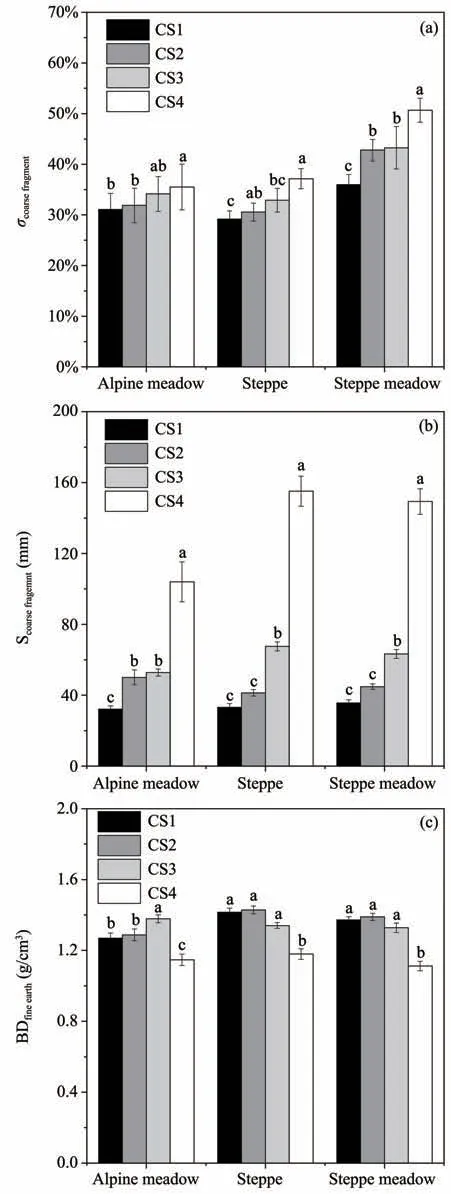
Figure 2 Mean relative volume of coarse fragment(σcoarsefragment)(a),mean size of coarse fragment(Scoarsefragment)(b)and bulk density of fine earth(BDfineearth)(c)in the top 1 m of typical grassland types.Error bars represent the standard error of the mean.CS1,CS2 and CS3 represent core samplers with diameters of 5,7,and 9 cm;CS4 represents large size sampler(30 cm in length,30 cm in width and 10 cm in depth)
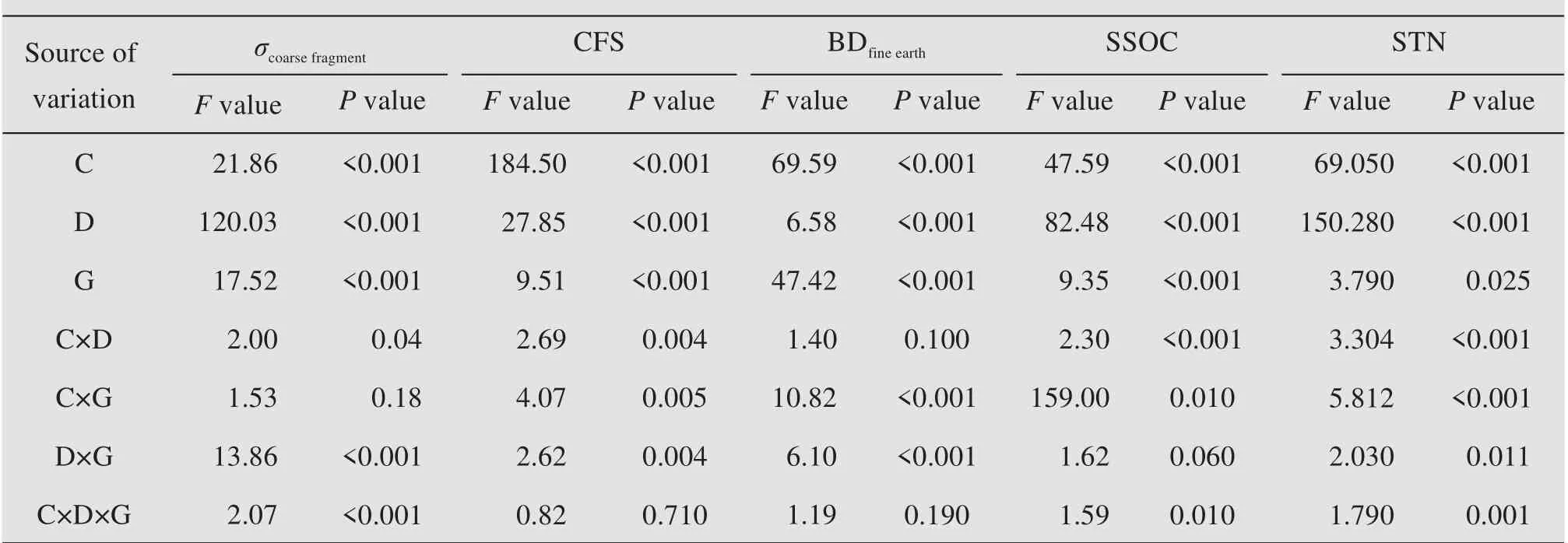
Table 3 The effect of core samplers on σcoarsefragment,RFS,BDfineearth,SSOC and STN stocks
3.2 Stocks of SOC and TN
Soil sampler size significantly affected SOC(F=47.59,P<0.001)and TN stocks(F=69.05,P<0.001)(Table 3).Both SOC and TN stocks decreased from the upper to the bottom layers and appeared to be mainly constrained to the upper 50 cm.Below this depth,stocks were lower (Figures 3a −3f).For each grassland types,both SOC and TN stocks were less for CS4 than those of core samplers (CS1,CS2 and CS3) at each depth (Figure 3).Average SOC (Figure 4a) and TN stock (Figure 4b) in the top 1 m were also less for CS4 than those of core samplers(CS1,CS2 and CS3) in all three grassland types.Core samplers(CS1,CS2 and CS3) led to approximate 17%−31%and 18%−32% overestimation for SOC and TN stocks in alpine meadow,22%−34% and 23%−36% in alpine steppe,and 37%−45%and 38%−46%in steppe meadow.
3.3 Correlation of SOC,TN Stocks and bulk density of fine earth with the volume of coarse fragment
Correlations between SOC,TN stocks and the rel‐ative volume of coarse fragment are provided in Fig‐ure 5.Both SOC (P<0.05) and TN stocks (P<0.05)were negatively correlated with the relative volume of coarse fragment.Bulk density of fine earth was also significantly negatively correlated with the relative volume of coarse fragment,although the correlation coefficient was low(R2=0.35,P<0.05)(Figure 5c).
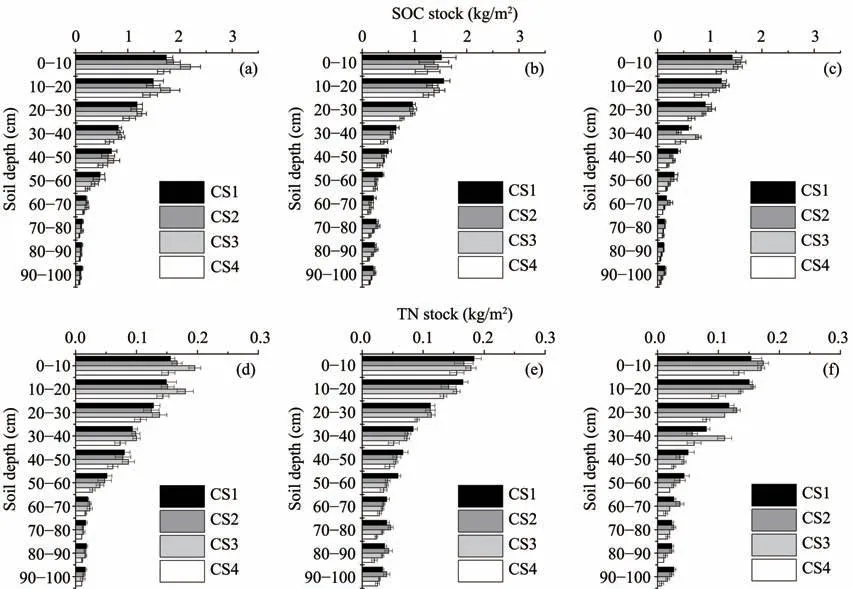
Figure 3 Soil organic carbon stock(SOC stock)of alpine meadow(a),steppe(b),steppe meadow(c),soil total nitrogen stock(TN stock)of alpine meadow(d),steppe(e)and steppe meadow(f)in soil profiles.Error bars represent the standard error of the mean.CS1,CS2 and CS3 represent core samplers with diameters of 5,7,and 9 cm;CS4 represents large size sampler(30 cm in length,30 cm in width and 10 cm in depth)
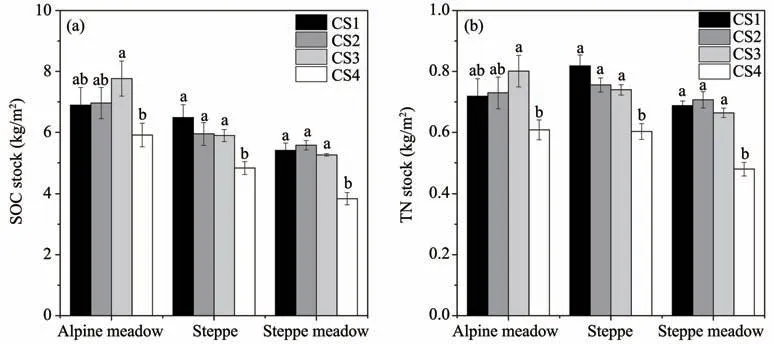
Figure 4 Soil organic carbon stock(SOC stock)(a)and soil total nitrogen stock(TN stock)(b)in the top 1 m of typical grassland types.Error bars represent the standard error of the mean.CS1,CS2 and CS3 represent core samplers with diameters of 5,7,and 9 cm;CS4 represents large size sampler(30 cm in length,30 cm in width and 10 cm in depth)
4 Discussions
Coarse fragment is common in soil profiles of dif‐ferent terrestrial ecosystems.For example,agricultur‐al soils containing coarse fragment accounted for about 30% of the surface area of Western Europe and even as much as 60% in the Mediterranean zone (Po‐esen and Lavee,1994).Similarly,relative volumes of coarse fragment were estimated to be 42%,43%−50%and 50% on average in the forest soils of Finland (Vi‐ro,1958),Sweden (Eriksson and Holmgren,1996;Stendahlet al.,2009) and England (Lyford,1964).This is also true for alpine grassland,were the mean relative volume of coarse fragment in the top 1 m is in a range of 36%−51% collected by large size soil sam‐pler (CS4) for three typical alpine grasslands in this study.This result was similar to that determined by large soil sampler (25cm×25cm×10cm in size) which reported that coarse fragment was 38%−58% for al‐pine meadow in the hinterland of the QTP (Yanget al.,2009a),but was larger than that determined by core clod method (with the diameter of 7.6 cm).This indicates that gravel content was 18%−35% for two typical alpine grasslands in the Central Western QTP(Wuet al.,2012).
Apart from the spatial distribution of sampling sites across the study region was different,the relative volume occupied by stone excluded by core samplers might be another cause for the difference in coarse fragment content.Coarse fragment size collected by larger size sampler (CS4) were all larger than 100 mm,while those collected by core samplers (CS1,CS2 and CS3) were all less than 70 mm (Figure 2b).In contrast with large size soil sampler (CS4),core samplers (CS1−3) led to approximate 9%−24% un‐derestimate of the relative volume of coarse frag‐ment for three typical alpine grasslands in our study.Taking into consideration substantial gravel and stone,large soil sampler is needed to determine the relative volume of coarse fragment,which is a criti‐cal factor for improving estimates of soil bulk densi‐ty and nutrient stocks,e.g.,soil organic carbon(Sten‐dahlet al.,2009).
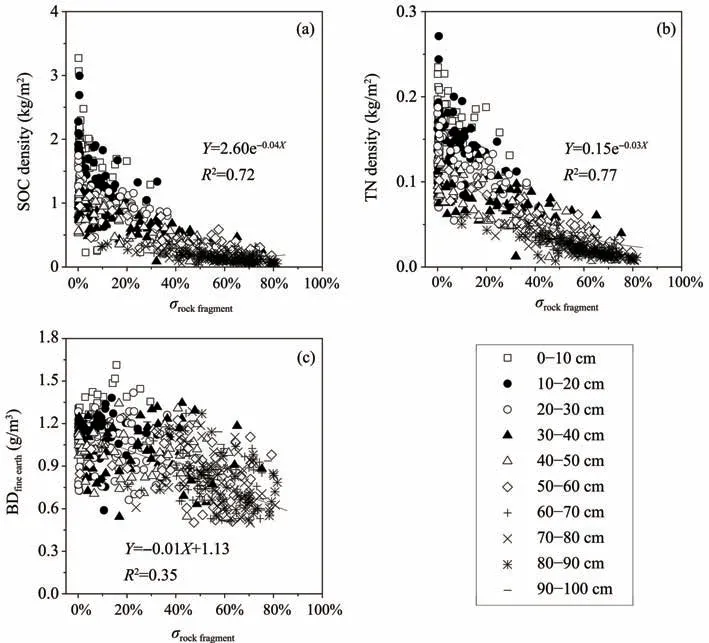
Figure 5 The relationships among the relative volume of coarse fragment(σcoarsefragment)and soil organic carbon stock(SOC stock)(a),soil total nitrogen stock(TN stock)(b)and bulk density of fine earth(BDfineearth)(c)
It is well known that large spatial heterogeneity in soil C stock inventories (Allenet al.,2010) and insuf‐ficient field observations (Changet al.,2014) led to great uncertainty in estimation of SOC stock.Soil sampler size should also not be neglected in field sam‐pling for stony soils.Bulk density is one of many es‐sential parameters known for calculating soil C and N stocks,but is affected significantly by coarse frag‐ment content (Stewartet al.,1970;Torriet al.,1994)and our results fit this pattern (Figure 5c).Soil parti‐cle size composition estimation based on core sam‐plers disregarding stones in soil do not refer to the whole soil volume.Hence,bulk density of fine earth is significantly overestimated due to coarse fragments that reduces space that is otherwise occupied by air,moisture and fine earth (Rytter,2012).Our results in‐dicate that core samplers led to approximately 14%−23% overestimation of bulk density of fine earth for three typical alpine grasslands.As a consequence,it results in the underestimation of the relative volume of coarse fragment but the overestimation of SOC and TN stocks.Calculated mean SOC and TN stock in the top 1 m based on large sampler ranged from 3.84 kg/m2to 5.91 kg/m2and 0.48 kg/m2to 0.61 kg/m2.These re‐sults are significantly lower than those calculated based on core samplers in this study (5.26 kg/m2to 7.77 kg/m2and 0.66 kg/m2to 0.82 kg/m2) and other studies in the same region (4.39 kg/m2to 8.70 kg/m2and 0.68 kg/m2to 0.81 kg/m2)(Liuet al.,2012).
Similar to the aforementioned studies (Jobbágy and Jackson 2000;Leifeldet al.,2005;Meersmanset al.,2012;De Baetset al.,2013),SOC stock (R2=0.72,P<0.05) (Figure 5a) and TN stock (R2=0.77,P<0.05)(Figure 5b) had a negative correlation with coarse fragment.However,this negative correlation de‐creased with the increasing of soil depth.Due to shal‐low root allocation and low turnover rates of organic matter in alpine ecosystems (Yanget al.,2009b),the distribution of SOC stocks in three grassland types was similar,with 89.61%,83.60% and 87.39% of to‐tal stock in the uppermost 50 cm for alpine meadow,alpine steppe and steppe meadow,respectively.The relative volume occupied by coarse fragment in the top 50 cm ranged from 10.99% to 36.09% for three grassland types.It has been suggested that relative volumes of stone and gravel were only 8%,however neglecting the volume occupied by coarse fragments led to an overestimation of C and N stocks by 8%−9%(Rytter,2012).Therefore,corrections should be made to the incorrect estimation of SOC and TN stock from core samplers using large size samplers on regions with gravel-rich soils in future studies.
5 Conclusions
In this study,we compared the difference in the rel‐ative volume of coarse fragment and bulk density of fine earth determined by larger size sampler and core samplers.Furthermore,we analyzed the uncertainties in estimating SOC and TN stocks caused by coarse fragment content determined with this soil sampler procedure.Our results demonstrate that core samplers were unable to collect stones,which shows that the relative volume of coarse fragment was underestimat‐ed but bulk density of fine earth,SOC and TN stocks were overestimated.Due to high volume of coarse fragment in alpine grassland soils,more attention should be paid to gravel and stone in estimates of soil C and N stocks and corrections should be made to the results from core samplers using large size samplers in future studies.
Acknowledgments:
This study was jointly supported by grants from the National Natural Science Foundation (42071139),Gansu province Science Fund for Distinguished Young Scholars (21JR7RA066) and the independent grants from the State Key Laboratory of Cryosphere Sciences(SKLCS-ZZ-2021).
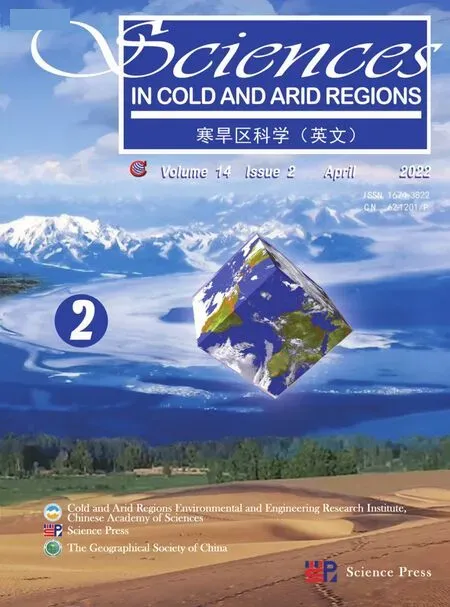 Sciences in Cold and Arid Regions2022年2期
Sciences in Cold and Arid Regions2022年2期
- Sciences in Cold and Arid Regions的其它文章
- Editor-in-Chief Yuanming Lai
- Estimating snow depth or snow water equivalent from space
- Influence of meteorological elements on chemical evolution of snow and ice of Urumqi Glacier No.1,eastern Tianshan Mountains
- Diversity and composition of culturable fungi in Horqin Sandy Land
- Effect of GGBS on performance deterioration of non-dispersible underwater concrete in saline soil
- Simulation assessment and prediction of future temperatures in Northwest China from BCC-CSM Model
